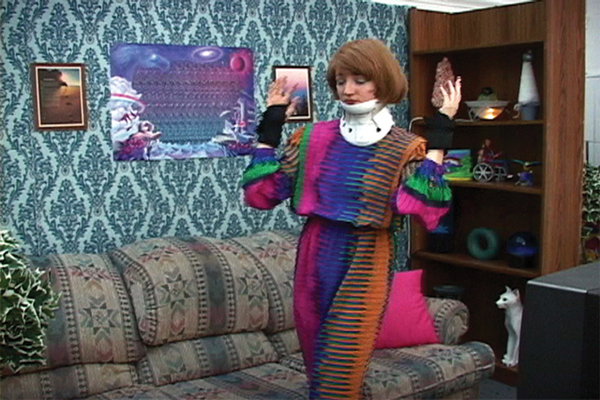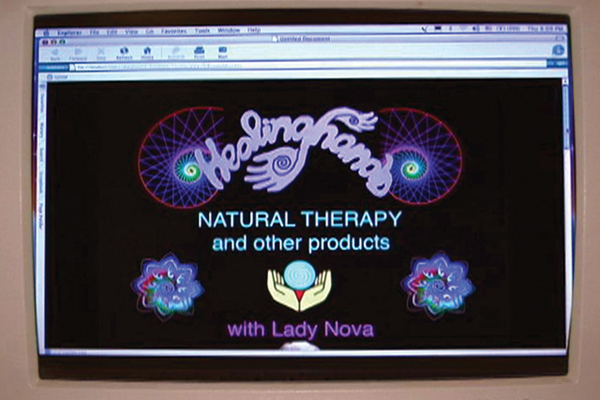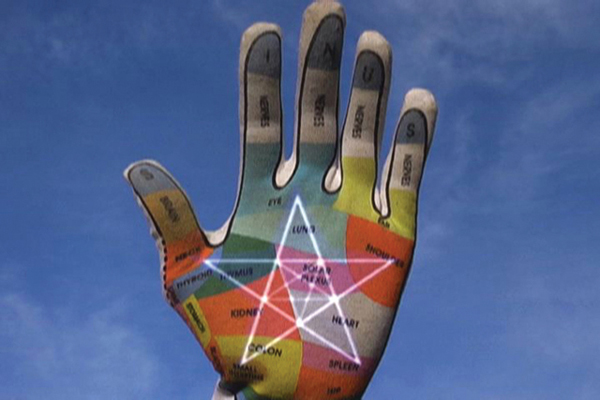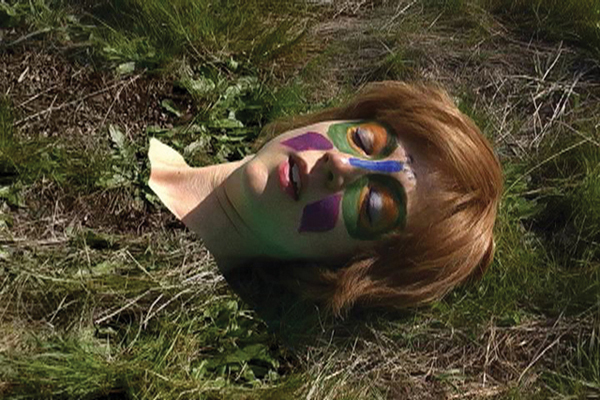Now That I'm A Woman,
Everything Is Strange *
By Thomas Beard
| Clockwise from top left: Whispering Pines 2, Whispering Pines 3, Whispering Pines 4, Whispering Pines 3 / Shana Moulton |
Whispering Pines 1 (2002), the first episode in an ongoing cycle of videos by Shana Moulton, is a brief but bewildering emblem of the prevailing ideas and preoccupations that have come to characterize the artist’s recent work. In it we are introduced to Cynthia (the sullen star of the series, played by Moulton) on a trip to the grocery store, but just as crucially we are introduced to her outfit: a house dress in muted pastels, augmented with a circular cushion sewn into the garment around her rear end. As she shops, glumly eying cans of organic kidney beans and massaging her awkward prosthetic, supermarket muzak is overlaid with what may be an internal monologue until all noises devolve into a slurping drone. Then the gravitational pull of the butt donut draws the camera’s gaze toward it, and the plush appendage transmogrifies into a screen (or is it a portal?) where, agog, we watch a mechanical parrot—complete with LED eyeballs—enter a room of miniature dimensions. It is a potentially unremarkable scenario made transcendently bizarre by Moulton’s intervention. To Be Continued… Indeed!
The second installment of Whispering Pines (released 2003) marks Cynthia’s return home, and it is this domestic setting that allows Moulton’s aesthetic interests to be more fully realized. The living room is a kind of perceptual contradiction, austere yet visually hyperactive. An otherwise spartan interior, it is also populated by a handful of carefully arranged elements: a mounted orb, an encasement of plastic flowers, a bowl of glowing crystals, all of vaguely New Age provenance, all of them plugged in (their cords, umbilical, are creepily conspicuous) and methodically activated by Cynthia upon her arrival, although the sounds of their preprogrammed gurgles do little to soften her dour expression. Whispering Pines is a kind of melodrama, its heroine a faltering, rather than fallen, woman, and it affirms the genre’s demand for a primacy of objecthood. Douglas Sirk famously noted that "you can't make films about things, you can only make films with things, with people, with light, with flowers, with mirrors, with blood," but Moulton extends this logic of artifice one step further. Even her flowers are fake.
 Whispering Pines 2 (2003) / Shana Moulton
Whispering Pines 2 (2003) / Shana Moulton
As a serial form, however, Whispering Pines is not so much a soap opera as a one-woman Twin Peaks. À la Lynch, inexplicable images reappear in variously altered states; the robo-bird of the project’s first chapter becomes, literally, a puzzle (jigsaw) later on. One could even say that every physical artifact in Moulton’s work—from oblong, rainbow-hued dreamcatchers to diamond-shaped, push-button wall lights—lead a double life, as objects in space as well as two-dimensional video scraps, ready to be animated or otherwise repurposed. Equally Lynchian is the way a subtle sense of unease seeps through little pockets of the narrative: Cynthia is suddenly wearing a fluorescent neck brace for reasons unknown, her cat goes missing. She worries about little lost Neefers in her diary, later making a remark in its pages about a wooden towel rack that could apply to all of the wonderfully strange and densely layered Whispering Pines, “I really like its texture, but I can’t understand what it is trying to say.”
Though even while it flirts with something more sinister, the tone overall is a humorous one. Like Michael’s Smith’s recurring everyman “Mike,” or Wynne Greenwood’s Tracy + the Plastics, Moulton’s Cynthia belongs to a significant vein within the history of video art, one where performers have constructed elaborate, straight-faced alter-egos that serve as conduits for their deadpan wit. There’s something undeniably droll about the compositional excess achieved in the aggregation of items like neon sand art or 3D Magic Eye posters. Of course it would also be a mistake to think of Whispering Pines as simply poking fun or laughing at the ridiculousness of those products and their quasi-psychedelic ilk.
 |
Image: Still from Feeling Free with 3D Magic Eye Remix (Shana Moulton, 2004). Courtesy of the artist.
|
A major achievement of Moulton’s saga is the way she chooses as its constituent elements that which is aesthetically disreputable, aggressively unhip. She approaches objects rarely, if ever, given serious thought and forces us to look at them in new and surprising ways. In 2008, at alternative space Participant, Inc. in New York, Moulton performed in front of a projection that at one point featured a seemingly endless array of logos, culled from the internet, of various organizations or merchandise related to the rubric of “women’s health”—Centers for Women’s Health, Women’s Health Expos, Women’s Wellness Expos, Oil of Olay—each predicated on an almost identical visual trope of curvy, line drawn figures, frequently in motion (so robust is the stick woman’s health that she is often caught leaping about). The practice of appropriating and reconfiguring images that depict socially constructed gender norms or ideals has long been a prominent concern within feminist art (Martha Rosler’s transformations, via collage, of nudie mag centerfolds into walls of bare flesh are a particularly famous example) but Moulton raises a different set of questions by way of playful repetition. Whether this corporate icon of the wavy lady is insidious or innocuous, one can’t help but wonder what its ubiquity says about the culture whose focus groups approved it.
 |
Image: Still from Whispering Pines 4 (Shana Moulton, 2007). Courtesy of the artist. |
Similarly plumbed in Whispering Pines are the depths of New Ageism’s signs, symbols, and patterns. Cynthia, suffering as usual from some malady of living, visits Healing Hands near the Sierra National Forest, and what she finds is a triumph of mise-en-scène. Innumerable sculptural permutations of a single hand, palm held upward, are on view—an open-palmed hand chair, hand chandelier, hand-shaped lotion bottle. The room Moulton has fashioned serves as a kind of perverse hieroglyph. Whereas occult traditions of knowledge, stemming from medieval conflations of science and magic, were based upon purportedly ancient, precise, and exacting semiotic systems (systems, it’s worth noting, that would be creatively deployed by artists and filmmakers like Kenneth Anger, Harry Smith, and Derek Jarman, among others), New Age practices hold a more tenuous link to the past. A philosophical pastiche, its pervasive themes are often severed from history, and so Moulton’s construction presents a formal situation that suggests itself as translatable, yet whose ultimate meaning is fascinatingly unmoored.
And though its presence is oblique, one might also discover within Whispering Pines the political implications of a New Age ethos, which are cunningly critiqued. “I am more than my physical body,” intones a soothing voice—“sound medicine” emitted through conch shell headphones at Healing Hands—“I am endless, limitless, unbounded, unrestrained, and unrestricted. I am free to access the infinite, open to my true dynamic nature, constantly changing, shifting, continually adapting, evolving, perpetually expanding and transcending. I am more than my physical body… My awareness is capable of transcending the physical, capable of transcending any limits imposed by my waking physical reality. I have had many experiences that proved this to me, beyond the shadow of a doubt.”
 |
Image: Still from Whispering Pines 4 (Shana Moulton, 2007). Courtesy of the artist. |
Though apparently the anodyne byproduct of a mishmash of west coast hippiedom and Eastern religion, the contents of the meditation tape are by no means outside of ideology. While the mini-mantras are supposed to be empowering, they in fact point to the very heart of the anxieties that riddle Whispering Pines. Cynthia inhabits a world that is constantly in danger of material and corporeal collapse—ersatz video screens emerge out of prosthetic orifices, her joints ache, her pores blacken, she vomits chroma key at a rave gone bad, and even disappears completely. Leaving the broader world of human relations free of culpability, New Age thinking is a potentially conservative ideology of personal responsibility as expressed in a belief in the ultimate supremacy of one’s own psyche—“You Can Change the Way You Feel” reads the chapter heading of The Feeling Good Handbook, Cynthia’s bedside tome—yet, in a manner reminiscent of Julianne Moore in Safe (1995), she can’t change the way she feels. Like Todd Haynes’ film, Whispering Pines is a careful study in ontological disquiet, but Moulton’s terminally doleful persona is also the stuff of great physical comedy—exaggerated gestures, a gawky cadence—and the boundaries between comic and tragic are left to dissolve and reconstitute themselves with increasing regularity.
With her latest videos and performances, Moulton has fashioned a singular body of work, though it might also be fruitful to consider her practice in a broader, generational context. Alongside contemporaries such as Cory Arcangel, Paper Rad, and Michael Robinson, to name only a handful, her project has helped further establish appropriation as a definitive mode of the early twenty-first century, and the means by which it departs from earlier models of assemblage are central to what make the impulse so compelling. To be sure, important precursors to those trends can be found in boomer artists like Dara Birnbaum, Matt Mullican, Cindy Sherman, and Laurie Simmons, who, being part of the first generation to grow up with television, drew on a vocabulary of Pop forms (game shows, comic books, B-movies, doll houses) in their work that reshaped and frequently subverted the mass-mediated world around them. So what’s changed? In short, the archive has exploded. The notion of a coherent mass culture has been eroding for years, replaced instead by an ever-expanding field of subculture and market niche, all of which circulates in new ways via networked systems. Our lives are distributed differently, and to intervene as an artist now, to rummage through the dustbins of recent history, points toward something new.
 |
Image: Still from Whispering Pines 4 (Shana Moulton, 2007). Courtesy of the artist. |
* This text was previously published in Deterioration, They Said, edited by Raphael Gygax (Zurich: JRP Ringier, 2010). Reprinted by permission of the author.
ABOUT THE AUTHOR
Thomas Beard is a founder and director of Light Industry, a venue for film and electronic art in Brooklyn, New York. He recently co-curated the cinema for Greater New York 2010 at MoMA PS1 and is currently at work on the film program for the 2012 Whitney Biennial.




